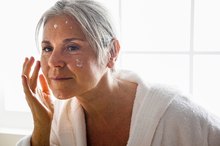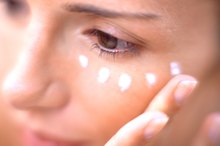Alpha Hydroxy Vs. Retinol
With all of the vitamins, minerals and chemicals contained in today's skin care products and an Internet full of misinformation, it's easy to get confused as to which ingredients you should look for on your product labels. Alpha Hydroxy Acids (AHA) and retinol, both commonly found in many skin care products, are also both known for helping to reduce fine lines and wrinkles. Yet, while they do possess some similarities, retinol tends to be bit more potent (often prescribed by a dermatologist) and is able to repair damage beyond the scope of AHAs.
Alpha Hydroxy Acid (AHA)
Alpha hydroxy acids, typically found in chemical peels to initiate exfoliation, are a family of acids commonly derived from citrus fruits, apples and grapes. They penetrate the skin to remove dead skin cells, leaving skin looking and feeling rejuvenated and more supple. In addition to reducing fine lines and wrinkles, AHAs have also been found to promote moisture, cleanse pores, brighten, and improve skin texture and clarity. The most common AHAs used in cosmetic products are glycolic, lactic, malic and citric acids.
- Alpha hydroxy acids, typically found in chemical peels to initiate exfoliation, are a family of acids commonly derived from citrus fruits, apples and grapes.
- In addition to reducing fine lines and wrinkles, AHAs have also been found to promote moisture, cleanse pores, brighten, and improve skin texture and clarity.
Retinol
The Difference Between Retinol and Retin-A
Learn More
It may surprise you to learn that retinol is actually the purest form of vitamin A. Products that contain retinol use the entire vitamin A molecule, which is renowned for its collagen stimulating properties. Found most often in acne and anti-aging products, retinol (like AHA) has been shown to help even pigmentation and improve skin texture, tone, color and moisture levels, in addition to helping smooth lines and wrinkles, often in a matter of weeks.
- It may surprise you to learn that retinol is actually the purest form of vitamin A.
- Products that contain retinol use the entire vitamin A molecule, which is renowned for its collagen stimulating properties.
Differences
While both AHAs and retinol are credited with removing dead skin cells and promoting cellular turnover, only the latter has also been shown to help repair damaged skin tissue and rebuild collagen, which is why it is so often found in acne and anti-aging products. How effective retinol is in this restorative process depends on potency and frequency of use. Over-the-counter products will typically have less retinol concentration than skin care products containing retinoids prescribed by your dermatologist. As a slightly milder alternative, opt for a product with AHA instead, making sure it contains at least 10 percent alpha hydroxy or glycolic acid.
- While both AHAs and retinol are credited with removing dead skin cells and promoting cellular turnover, only the latter has also been shown to help repair damaged skin tissue and rebuild collagen, which is why it is so often found in acne and anti-aging products.
- As a slightly milder alternative, opt for a product with AHA instead, making sure it contains at least 10 percent alpha hydroxy or glycolic acid.
Caution
The Best Skin Care Products for Women Over Age 50
Learn More
Anytime you introduce a new product into your skin care regimen, it is important to be aware of potential side effects that may occur. Both AHAs and retinol may cause redness and irritation to the skin upon initial use, and both can cause your skin to become especially sensitive to the sun, so it is best to use them only at night and to always wear sunscreen during the day. Don't use products containing retinol if you are pregnant, and never use AHA and retinol at the same time, as each will render the other ineffective. If redness and irritation persists for more than a few days, consult a dermatologist to make sure the product you are using is right for you.
- Anytime you introduce a new product into your skin care regimen, it is important to be aware of potential side effects that may occur.
- If redness and irritation persists for more than a few days, consult a dermatologist to make sure the product you are using is right for you.
Related Articles
References
- World Health Organization. Nutrition: Micronutrient deficiencies.
- Kong, R., Cui, Y., Fisher, G., Wang, X., Chen, Y., Schneider, L. and Majmudar, G., 2015. A comparative study of the effects of retinol and retinoic acid on histological, molecular, and clinical properties of human skin. Journal of Cosmetic Dermatology, 15(1), pp.49-57. doi:10.1111/jocd.12193
- National Institutes of Health. Office Of Dietary Supplements. Vitamin A: Fact Sheet for Health Professionals
- U.S. National Library of Medicine: MedlinePlus Medical Encyclopedia. Vitamin A. Updated February 2nd, 2019
Writer Bio
Kimberly Stredney is editor-in-chief of InWithSkin, an international skin care, health and beauty magazine. She has been writing since 2007 for newspapers and magazines including "The Chicago Sun-Times" and "Cleveland Magazine." She attended Northwestern University's Medill School of Journalism and has a master's degree in cultural anthropology from Brandeis University, and dual bachelor's degrees in anthropology/psychology and communication from Ohio University.









